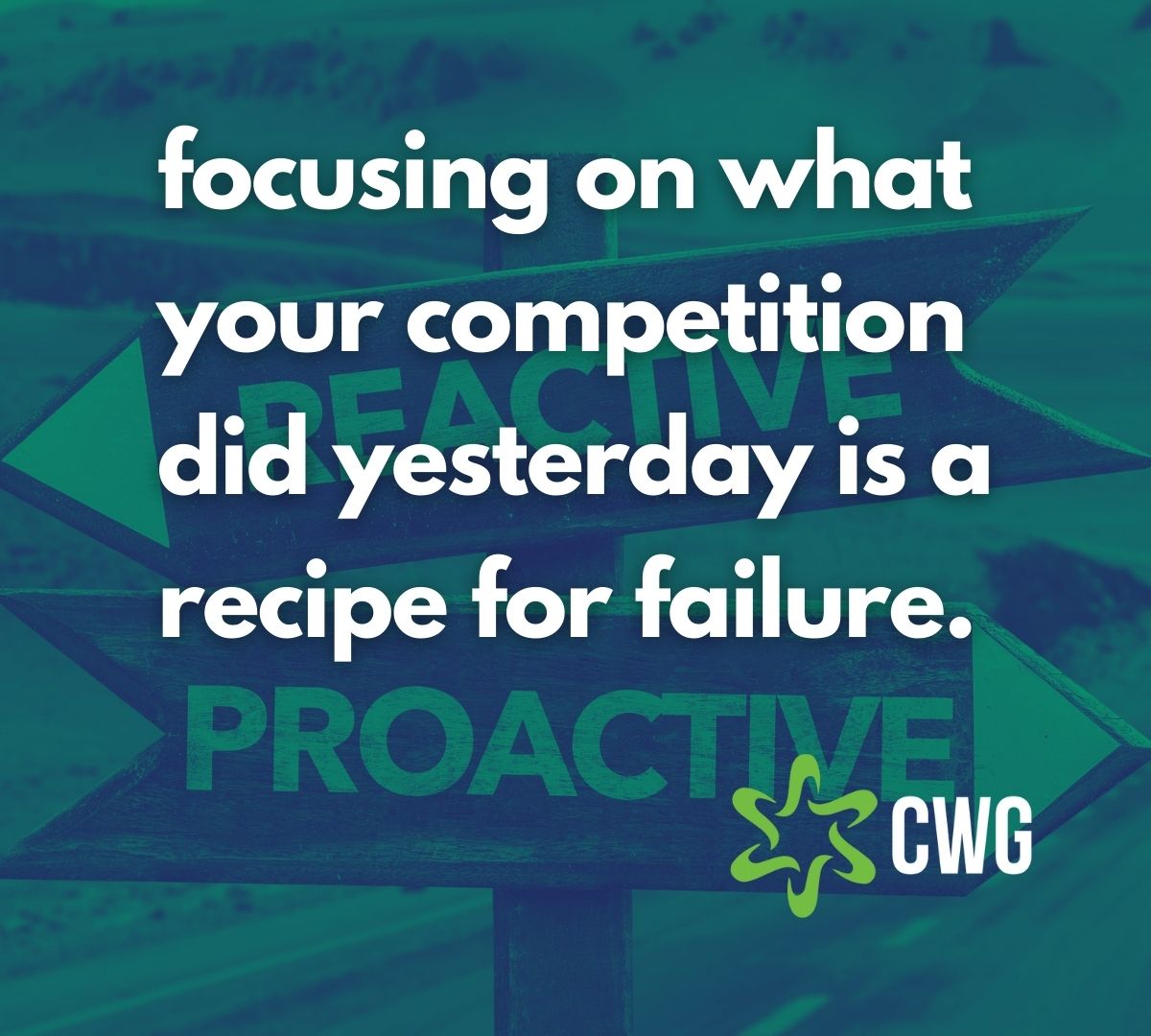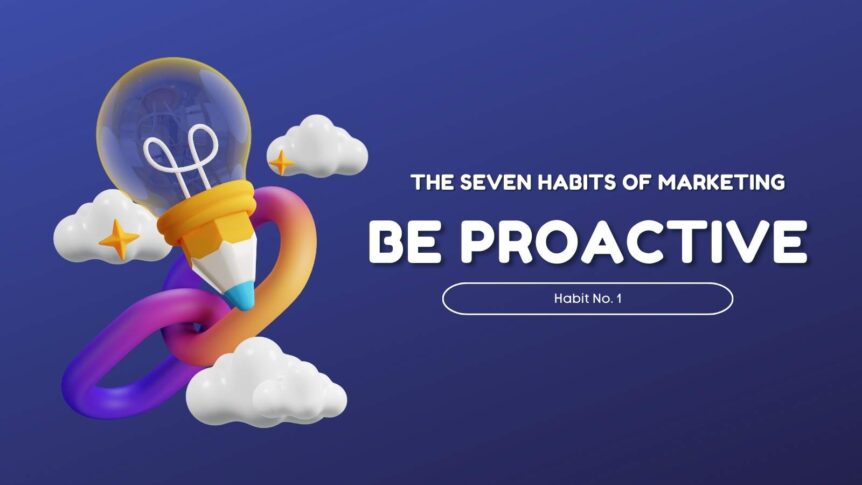The 7 Habits of Marketing
#1: Be Proactive
If you are a business owner and you have never read Steven Covey’s 7 Habits of Highly Effective People, stop reading this post and go pick the book, now. If you have read it before but haven’t picked it up in the past 12 months, I’d recommend pulling it off the shelf and giving it another read through.
Covey’s 7 Habits is one of the most influential books for business leaders written in the past 50 years. The book acts as a framework for setting up a highly effective and successful life through daily habits and routines. Basically, what it does is help you establish rules and values to base life decisions on. But 7 Habits isn’t just for individuals. Most successful businesses I know are already applying the 7 Habits in one form or another across their business. And if you apply the 7 Habits to your marketing, chances are you’ll stop feeling frustrated and start seeing improved results almost immediately.
I’m not going to discuss the finer details of the book, for that I encourage you to give it a read. But I will hit on the basic principles and how you can apply them to your marketing plan.
Day 1: Be Proactive
A common theme in conversations I have with prospective clients is “we need new blood”. They spent years, sometimes decades, feeding off the same customer lists, effectively cannibalizing their own product lines. But after time, those customers start to dwindle and after a while there’s not much meat left on the bone. Everyone has excuses for how their business got to this point – “We rely on referrals”, “Our customers are loyal to our products” “We want to focus on what works for the people that need our product”. To be fair, I’ve been guilty of using some of these excuses myself in the past.
And this is when businesses start interviewing marketing agencies like mine with the “we need new blood” mantra. And to make matters worse, this often accompanies statements like “we don’t have a budget right now because we don’t have new business coming in” or “I need to make this $5000 investment generate $50,000 by next month” because quite frankly, they’re out of customers, out of income and looking for a Hail Mary.
The number one way to avoid putting yourself in this situation is to BE PROACTIVE with your marketing.
Don’t wait until you have no more Joes coming around to start looking for new business. Start today and develop a constant stream of new leads pouring into the top of your funnel.
Another big problem we see a lot is businesses with a REACTIVE mindset to marketing. Meaning they don’t think SEO, SEM, SMM, Email marketing, whatever; will work for them because either:
- Someone told them it wouldn’t, based on their own previous bad experience
- Or, it’s not what their competitor is doing.
Before we talk about being proactive. Let’s talk about the 3 most common REACTIVE behaviors that stymie leads and destroy your sales funnel.
1 – Avoiding new business marketing by cannibalizing your own customer list.
A common theme in conversations I have with prospective clients is “we need new blood”. They spent years, sometimes decades, feeding off the same customer lists, effectively cannibalizing their own product lines. But after time, those customers start to dwindle and after a while there’s not much meat left on the bone. Everyone has excuses for how their business got to this point – “We rely on referrals”, “Our customers are loyal to our products” “We want to focus on what works for the people that need our product”. To be fair, I’ve been guilty of using some of these excuses myself in the past.
One of the key mistakes new restaurant owners make is they cater heavily to their regulars, providing dedicated seats or booths in the restaurant, giving away free food and drinks, and putting up with unruly behavior that drives away new customers. But hey “Joe eats here every other night. I’ve got to keep him happy, right?” Wrong. Joe eats there because you gained his trust by serving good food, having low prices, or just being conveniently located in the neighborhood. Regardless of the reason Joe decided to eat at your restaurant 3 times a week, it wasn’t because you gave him preferential treatment over other customers. Maybe you’re not a restaurant owner, but chances are you’ve been guilty of making concessions and giving away profit to keep an old customer in the funnel. I’m not saying loyalty programs don’t work. They absolutely do. But when businesses start to focus all their efforts on concessions to keep existing customers feeding at the trough – they ultimately drive down their profits and cannibalize their own business. Eventually Joe is going to go on a diet, or move to a new neighborhood, or just get tired of burritos and interested in the new Pho place that opened across the street and you’re going to be staring at any empty booth.
2 – Rejecting marketing concepts entirely based on word of mouth or past experience
Unfortunately, I run into this problem all the time when speaking with prospective new clients. For one reason or another they refute specific marketing channels because they don’t believe in them or a colleague, friend, or family member has told them it doesn’t work. I’ve had customers flat out refuse SEO, SEM, SMM, Email marketing and more based on a bad experience they (or someone they know) had in the past.
The truth is there are thousands of reasons why a specific marketing campaign can fail, from poor set-up to poor-execution, under funding/under saturation, over saturation, timing, competition and more. Hell, sometimes you can do everything right and they still fail. But rejecting a key component of generating new business based on a bad taste is flat out faulty reasoning and a reactive approach to marketing.
Instead, if you’re concerned that a specific marketing channel isn’t right for you, voice your concerns, and be open to a discussion on how those concerns can be alleviated or what alternatives are available. Maybe a test budget is a good solution, maybe setting benchmarks for performance will keep things on track, there are a number of ways to position your campaign for success without outright rejecting a tactic or channel you haven’t experienced before. A good marketer takes a holistic approach to generating leads and by removing one brick from the platform, the rest can become unstable. And on that note, you have to trust your marketing agency to do the right thing. If you don’t trust that they are experts in their field and know how to generate leads for you – run. Don’t hire marketers you feel you need to micromanage and don’t hire marketers you feel force you into one size fits all approaches. Hire a marketer you believe can leverage your strengths across a variety of platforms for added value and success.
3 – I want to copy my competitor
Over my career I’ve run into this one several times. And a lot of the time it makes me cringe. Basically, customer A wants to duplicate competitor B because competitor B is the biggest business on the block. So… “what they’re doing to be successful has to work for me too, right?” I’m all for the philosophy of Steal Like An Artist (another great read), but when you make a concentrated effort to duplicate the branding, identity, messaging, and strategy of your direct competitor you don’t add value to your positioning. It’s a REACTIVE mindset. You come across as a copycat with no ability to add value to your customers experience. If your customer wanted Competitor B’s offering, they’d just use Competitor B anyway, you’re not going to win them away by being a clone. Plus, a lot of the time, the businesses that want to use this strategy don’t have the resources of the competitor they are trying to copy. They want to do exactly what their competitor is doing to get business, but they don’t want to spend what their competitor is spending. This is a common theme in failed SEO campaigns. Smaller businesses try to attack the market using the same keyword strategy and audience as their larger competitors and then wonder why it failed (setting up a future distaste for the channel). Let me be clear, focusing on what your competition did yesterday is a recipe for failure.

The best brands, big or small, spend a lot of time and effort cultivating their own brand personality – one that works for them. Trying to imitate another brand’s persona is a disservice to you customers and your industry and ultimately makes it that much harder to succeed. A business professor I had in college once said, “You either have to be the first to market, or you have to build a better mousetrap.” Instead of trying to duplicate someone else’s success, take the time to build a better mousetrap, a marketing plan that is going to work for you, your business, your products, and your customers and you’ll see far greater success than you would stealing from those that came before.
So, what are PROACTIVE marketers doing to set themselves up for success?
1 – Build a plan.
I can’t stress this enough. I see far too many businesses with segmented approaches to marketing. They’ve got a social media marketer working over here, a website designer working over there, a standalone SEO agency, a service for emails run by a third party and a sales team that doesn’t know the names of any of these people. Sometimes building a team through outsourcing and channel segmentation is a good thing. After all, we all can’t be experts in everything. But just like building a house, you need to have a general contractor that runs the show. Someone needs to pull all these subcontractors together so that the work fits seamlessly together and generates a return on your investment. Having a plan in place, not only allows your general contractor to make sure the house gets built, but it defines roles and objectives and holds each party accountable for their own part of the campaign. I like to say numbers don’t lie. Don’t tell me your feelings or assumptions, show me the numbers and I can almost always show you where and what is working and what went wrong. A solid marketing plan gives you the foundation you need to weigh outcomes against your investment and determine if that specific campaign is working or if you should cut bait.
2 – Market when you’re busy.
We all tend to fall into the habit of slowing down or stopping work on our marketing campaigns when we get busy with revenue generating activity. Afterall, that’s money in the bank, so why not give it 100% of your attention. The problem is we can’t just look for customers when business is lean. By then we’re usually cash strapped, desperate and against the clock. Ask any marketer and they can tell you a story of a business coming to them with the goal of tripling or quadrupling their revenue inside of 30 days. They almost always have a definitive timeline for their ROI and it’s rarely realistic. Why? They’re out of money and out of time. Again, at this point they are looking to marketing as a Hail Mary to keep their business running. Marketing is not a short term stop gap solution. It has to be a long term, permanent component of your business strategy. Every industry has ebb and flow, the best way to ensure you always have enough prospects in the funnel is to maintain regular marketing activity.
3 – Do something. Anything.
Another key to being a PROACTIVE marketer is to always do something. Anything. Seriously. Don’t get caught up in analysis paralysis or refuse to start a campaign because you don’t know if it will work.
Last year I worked with a start-up as a marketing consultant. Their goal was to launch a SAAS model to the public within 12 months. At the 8 month mark we had the corporate identity, messaging, an investor strategy and go-to-market strategy all complete and nearly had the software that served as the backbone of their service wrapped up. All we needed to do was push the product live. The COO broke from the plan and started re-analyzing every component of the business. He felt that we had “one chance to get it right” and didn’t want to roll out the platform or market it until he was 100% sure that everything was perfect. The 12 month mark came and went with little progress. The 14 month mark came, and the CEO and investors started to panic. The COO relented and rolled out the product with zero PR or marketing behind it. His opinion was he wanted to let the market test it first and see the response, then we could market heavy. Well, releasing a business onto the internet is a little like releasing a bird into the wild. No one is going to notice if you don’t tell them. First quarter sales flatlined. Everyone panicked and rash decisions started to get made in the equivalent of throwing darts at a board blindfolded. The remaining budget was burnt through in record time with zero return. The owners started seeking angel investors and trading stock for services. And the startup folded. It was a great idea and a novel one that could have really impacted an industry. But failing to do anything ultimately doomed the company.
The old adage of how to eat an elephant applies to starting a marketing campaign. One bite at a time. Even if you don’t know everything to do, do something and take small bites so you can chew, digest and take another. Start with a small budget and focus on a medium that promises the most return. And once you’ve dialed that in, start another. A good marketing consultancy can guide you on building a scalable marketing plan that can grow with your business.
4 – Test. Analyze. Optimize.
PROACTIVE marketers are constantly seeking to improve their clients’ ROI and streamline their processes. This means taking the time to dive into the numbers and understand the performance of your campaigns. First impressions aren’t always right. So, test your campaigns. Run A/B split tests. Alternate messages and frequencies, and test price points and promotions. Then analyze to see what messages, what audiences, and what frequencies work best for your product. Once you’ve identified that, optimize your campaigns based on your findings. Make this your new baseline for performance and start testing again. PROACTIVE businesses are never satisfied or complacent. They are always looking for ways to improve their product and their position in the market. Even when things look good, keep your nose to the grindstone and you’ll find success.

